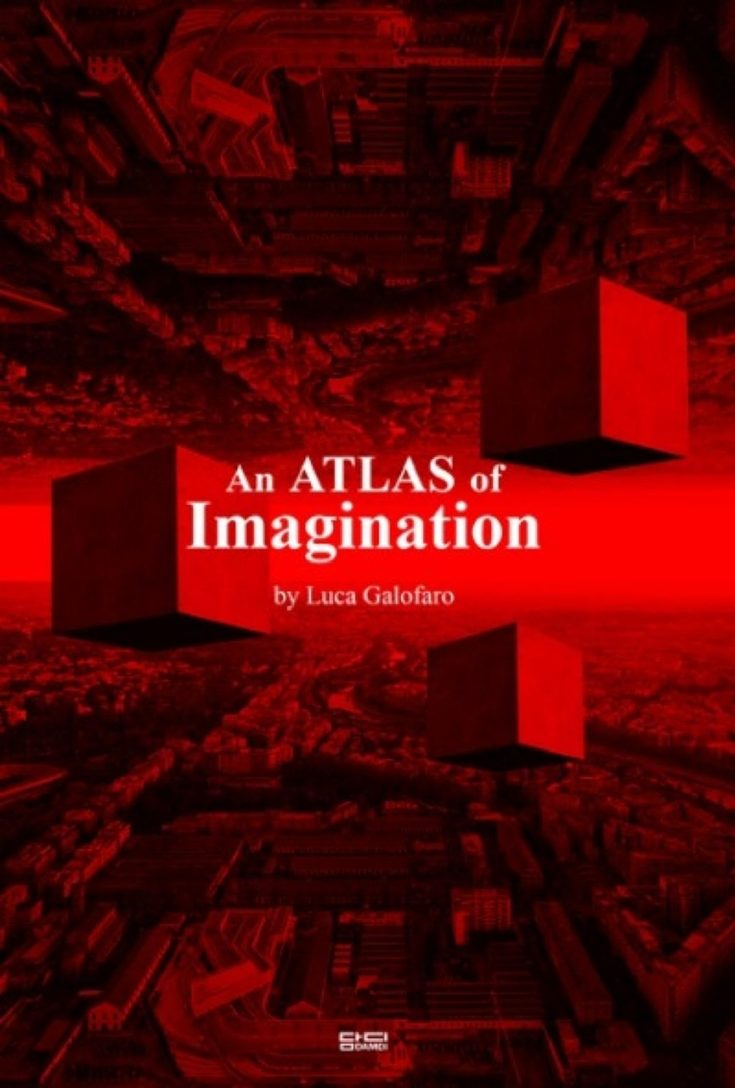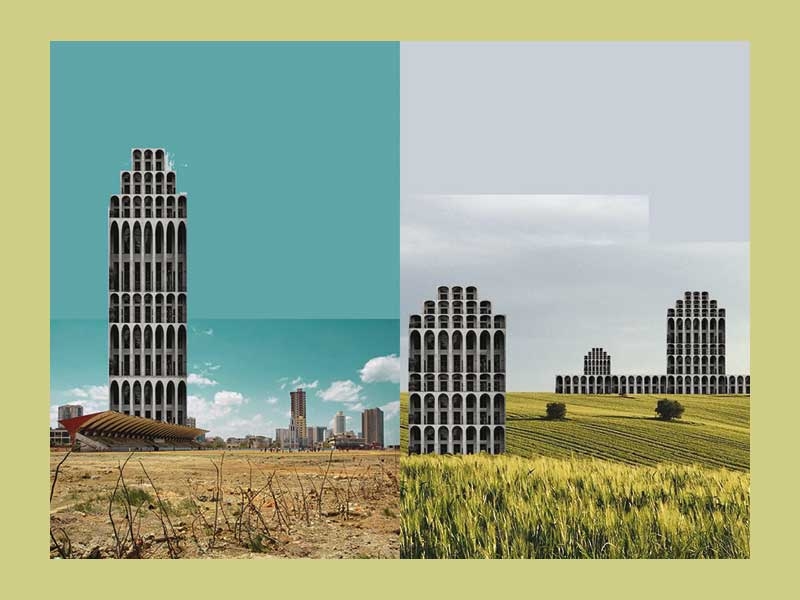Luca Galofaro, architect and educator
An Atlas of imagination, by Luca Galofaro, DAMDI publisher, Seoul 2015

The object of Luca Galofaro’s research is the relationship between images and architecture.
Before beginning my university degrees I started doing some photomontage in order to put together an illustrated text through which I could ponder on the Form I would use to represent the human being in the outer space. Drawing architecture in another dimension, with completely new physical characteristic as the gravity absence, it was a complicated thing. Architecture was limited to be an iconic object, but also technologically complex. I had chosen space fragments of reality in order to investigate the discipline outside the urban space we all know. Objects, architecture, landscape’s fragments once carried in the space were losing their meaning or better they were acquiring a different one. Not only on a conceptual point of view but also on a psychological one, this images were building a story, a text able to return to the place a familiar and reassuring identity. The archetype on this analytical phase of my work was building the palimpsest of a wider reflection on the possibility of architectonic shape. My Atlas of imagination takes shape through a series of successive collages in which images and texts are compared. Write annotations is both a design process and a practice that I try to develop as theoretical approch. The idea is not to emphasize the similarities between images, but the possible connections between different lines of research, working on the process of construction of new meanings. Of course individual images have no artistic value in itself, but act on the creation of an interpretive tool.
Could you identify some constants in your work?
In my work as architect Images become models not describing but underlining resolute conceptual decisions on a specific themes. Giving indications, creating the conditions to reflect, places to debate. The observer become content’s producer through his reflections. The structure, the form, the space, the necessity to use the architectonic shape as an expressive one, are secondary compared to the collected themes .
Montage is used as an instrument to take note on ideas, produce narrative strategy through simple operations: multiplying signs, scale exchange, reversals, grafts, superimposing, erasing. Necessary operations to pose relative questions on a project that only at a later stage can be applied on architecture. The annotations are the first instrument through which we can put some order on a personal storage. The storage is generated by an affection on signs, a fragment, a space, an image striking us more than another, we store it, therefore to images we combine texts, quotes taken from books being its integral part. Annotations put one next to the other make an interpretative Atlas of reality. Taking notes is a project process and a practice I try to develop in a methodological key. It’s true that in this way I have the possibility to re-organize fragments of reality, to build my Atlas.
How did you find out about Aby Warburg’s work? What interests you the most?
I’m fascinated by the idea of using an Atlas to built out from my memory architecture images, able to built real spaces.
How would you define an Atlas?
According to a definition by Aby Warburg, who employs photos to build a cognitive process: cut out, reproductions are used to organize a tale, then the charts produced are fixed through a photo representations which determine an accurate place of the fragments, montages create sequence to be interpreted. To build an Atlas that way is a research experience to construct new meanings.
Atlas as a conceptual, formal and mnemonic device; do you use it in your work?
The atlas for me is a tool to reorganize my memory and my visual archive.
Luca Galofaro uses a mnemonic system to organize his materials: Il palazzo della memoria.
‘The method of loci’, an imaginal technique known to the ancient Greeks and Romans and described by Yates (1966) in her book The Art of Memory. In this technique the subject memorizes the layout of some building, or the arrangement of shops on a street, or any geographical entity which is composed of a number of discrete loci. When desiring to remember a set of items the subject ‘walks’ through these loci in their imagination and commits an item to each one by forming an image between the item and any feature of that locus.
(O’Keefe, John; Nadel, Lynn (December 7, 1978). The Hippocampus as a Cognitive Map’. Oxford: Oxford University Press)
In your work, do you identify formal or conceptual recurrences such as repetitions and disruption, distance and proximity, identity and migration, conflict and colonization?
Georges Didi-Huberman wrote that the Atlas is not only a collection of images, but a “form of visual knowledge and an infinite archive that acquires meaning through the concept of montage”. Didi-Huberman never refers to a single image, but to images as a complex system, a collection of fragments. For him, just as for Aby Warburg, the way images are organized among themselves is essential, as well as how different combinatorial possibilities stimulate a different reading path. Assembling images – as I do in my work – does not mean assimilating them to make them fit into a logical narrative plot, but rather juxtaposing single fragments, storing their multiplicity, partiality, and impurity so that their combination or repetition generates an interference with, or a reaction to my imagination, opening up new possible relationships and knowledge. The images should not be looked at by themselves; they should always be juxtaposed to other images; in my Atlas, in particular, they are completed by short sentences taken from the books in my library. Words to be read to amplify the meaning of the image, not to affirm a single truth, but to trigger a visual moment of awareness. Only through this dialectical relationship can the image acquire a new legibility. The image, in fact, becomes the center of a thought about time. In a sense, it is the attempt to construct an atlas of one’s own imagination, whose constant reference point is Warburg’s Mnemosyne Atlas; unlike the latter, the images juxtaposed in this Atlas were first manipulated and customized through a process of assimilation. Aby Warburg’s work is a system of classification and assembly of images according to an analytical criterion. He created a method, drawing an interpretative map of the history of art, an atlas through which it is possible to analyze specific topics. The atlas emphasizes the relevance of the art of montage, as the juxtaposition of photographs, simply mounted on a black background, breaks the evidence of the reliability of its own claim. Through montage, Warburg created figures in a dialogue with the onlooker through the conflict or simple contrast of fragments. Through the Atlas, he highlighted the fault line of exploration. As Didi-Huberman pointed out in many of his writings on Warburg, this is not an instrument of depletion of given possibilities, but rather a limitless breach to possibilities not yet given. Its origin, its driving force, is only imagination, and the ability to look inside the image. Warburg committed his scholarly activity almost entirely to the construction of this Atlas of imagination. A visualization of the main topics he studied during his life, realized with the help of photographs of works of art, but also of objects and figures taken from everyday life, such as stamps and newspapers. Arranging a body of work that was always open to integrations and new connections. Proceeding through the history of ideas, Warburg investigated the extent to which the formula of experience was an artistic lesson coming from the past, reborn to new life in Renaissance art. Images travel in time, locally and culturally, following official channels, books, museums, works; they travel on the web as fragments; and during all these transfers they are subject to transformations, not always physical, due to the variations in the mentality of those who look at them. The path of the archetype has distant origins, and the atlas is an attempt to produce a historical geography of ideas through the symbol contained within repeating figures.
In Luca Galofaro’s work, the text is just a fragment he uses to built an image.
Thinking about Warburg’s ‘good neighborhood rule’, what are the books that underpin your project?
Denis Gielen, Atlas of Contemporary Art for Use by Everyone, Exhibitions Intl, 2007
La Grande Madre, a cura di Massimiliano Gioni, Skira 2015
Lewis Baltz, Common objects. Hitchcock-Antonioni-Godard, Steidl/Le Bal 2014
Georges Didi-Huberman, Soulèvements, Galimmard, 2016
Eva Schmidt, Lieber Aby Warburg. Was tun mit Bildern? (Dear Aby Warburg What can be dome with images?), Kehrer, 2012
Exhibition:
Georges Didi-Huberman and Arno Gisinger, Nouvelles histoires de fantômes, Palais de Tokio 2014
Luca Galofaro is an architect and an educator. Associated professor at Università di Camerino SAAD Ascoli Piceno. Founder member of IaN+ (1997-2015) and LGSMA (2016-2020). Member of the colletive of research CAMPO www.campo.space. Co-Curator of the first and second Architecture Biennale in Orleans at the Frac Centrre Ville de Loire in October 2017 and 2019. Gold medal of Italian architecture in 2006, selected for the Iakov Cernikov prize 2010, finalist to the Aga Khan award in 2013. Visitor professor at UCL the Bartlett school of Architecture, visiting at Ecole Spéciale d’Architecture in Paris, Confluence in Lyon, Cornel University Rome Program and at the Kent State University Florence program. He obtained the Master degree on Spatial Science at the International Space University, UHA Huntsville, USA. He is author of several books Artscapes. Art as an approach to contemporary landscape Gustavo Gili Barcellona 2003. (Postmedia books milano 2006), Aristide Antonas Libria 2014, An Atlas of Imagination DAMDI 2015, Manthey Kula Libria 2016, Nos Années de solitude Les presses du reel 2019.







